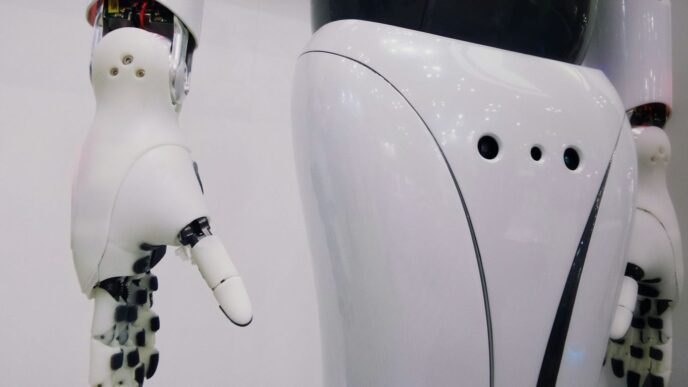So, you’re probably hearing a lot about AI these days, especially how it’s changing pretty much everything. Well, guess what? Supply chain management is no different. We’re talking about how smart computer programs are making things like getting products from one place to another way more efficient. This article is all about how artificial intelligence is changing the game in supply chain management, from the big ideas behind it to how it’s actually being used in today’s businesses. It’s a pretty big deal, and it’s only going to get bigger.
Key Takeaways
- AI is changing how supply chains work, making things faster and smarter.
- Using AI helps companies guess what customers want better, so they don’t run out of stuff or have too much.
- AI makes shipping and warehouse jobs easier and more organized, like finding the best routes for trucks.
- Companies can use AI to pick good suppliers and avoid problems before they happen.
- The future of supply chains will have a lot more AI, so people in these jobs will need to learn new skills.
The Foundational Role of Artificial Intelligence in Supply Chain Management Theory
Redefining Supply Chain Paradigms with AI
Okay, so, AI is changing everything about how we think about supply chains. It’s not just about making things a little faster or cheaper anymore. It’s about completely rethinking the whole process from start to finish. We’re talking about moving away from traditional, linear models to more dynamic, interconnected systems. Think of it like this: old supply chains were like a one-way street, but AI is turning it into a complex network where information flows in all directions. This shift requires a new way of looking at things, a new set of assumptions, and a willingness to experiment with different approaches. It’s a bit scary, sure, but also super exciting.
Theoretical Frameworks for AI-Driven Optimization
There’s a lot of theory behind using AI to make supply chains better. It’s not just throwing algorithms at the problem and hoping for the best. We’re talking about stuff like game theory, network optimization, and control theory. These frameworks help us understand how different parts of the supply chain interact and how AI can be used to make better decisions. For example, game theory can help us model the interactions between suppliers and buyers, while network optimization can help us find the most efficient routes for transporting goods. It’s complicated stuff, but it’s essential for building truly intelligent supply chains. You need to consider change management to make sure everyone is on board.
Integrating Machine Learning into Supply Chain Models
Machine learning is a big part of all this. It’s how we teach computers to learn from data and make predictions about the future. In supply chain management, this means using machine learning to forecast demand, optimize inventory levels, and identify potential disruptions. The cool thing about machine learning is that it can adapt to changing conditions and improve over time. So, as we collect more data, our models become more accurate and our decisions become better. It’s like having a super-smart assistant who’s always learning and getting better at their job. Here’s a quick look at some common applications:
- Demand Forecasting: Predicting future demand based on historical data.
- Inventory Optimization: Determining the optimal level of inventory to hold.
- Risk Management: Identifying and mitigating potential supply chain disruptions.
Predictive Analytics and Demand Forecasting with Artificial Intelligence
Okay, so predictive analytics and demand forecasting with AI? It’s a big deal. I mean, everyone wants to know what’s coming, right? Especially when it comes to supply chains. If you can guess what people will buy, you can make sure you have it. And that’s where AI comes in. It’s not perfect, but it’s way better than just guessing.
Leveraging AI for Enhanced Demand Accuracy
AI can really help with figuring out what people want. It’s not just about looking at last year’s sales. It’s about looking at everything. Weather, social media, even what’s happening in the news. AI can take all that data and make a pretty good guess about what’s going to sell. It’s like having a super-powered crystal ball, but instead of magic, it’s math. For example, a TechAnnouncer article might talk about how AI can analyze customer behavior to predict future demand.
Real-Time Insights for Inventory Optimization
Knowing what’s going to sell is only half the battle. You also need to know when to order more stuff. And how much. AI can help with that too. It can track inventory levels in real-time and make suggestions about when to reorder. It’s like having a personal assistant for your inventory. Here’s a simple example of how AI might adjust inventory levels based on demand:
| Product | Current Inventory | Predicted Demand (Next Week) | Recommended Order Quantity |
|---|---|---|---|
| Widget A | 100 | 50 | 25 |
| Widget B | 50 | 75 | 60 |
| Widget C | 200 | 100 | 0 |
Mitigating Supply Chain Volatility Through AI Predictions
Things change. A lot. And sometimes, they change fast. AI can help you deal with that. It can spot potential problems before they happen. Like a supplier going out of business, or a port getting shut down. By knowing about these things in advance, you can take steps to avoid them. It’s like having a warning system for your supply chain. Here are some ways AI can help:
- Identifying potential disruptions early.
- Suggesting alternative suppliers or routes.
- Adjusting production schedules to meet changing demand.
Optimizing Logistics and Transportation Networks Using Artificial Intelligence

Logistics and transportation are ripe for AI disruption. Think about it: so much of what makes these systems tick involves tons of data, complex routes, and a constant need to adapt to changing conditions. AI is really good at all of that. It’s not just about making things a little better; it’s about fundamentally changing how goods move from point A to point B. AI’s ability to process massive datasets and make quick decisions is transforming logistics and transportation networks.
AI-Powered Route Optimization and Fleet Management
Remember the days of relying on basic GPS and gut feelings for route planning? Those days are fading fast. AI algorithms can now analyze traffic patterns, weather conditions, construction delays, and even the performance history of individual vehicles to create the most efficient routes possible. This isn’t just about saving a few minutes here and there; it’s about significantly reducing fuel consumption, minimizing wear and tear on vehicles, and getting deliveries to their destinations faster. Plus, AI can help with fleet management by predicting when vehicles need maintenance, optimizing driver schedules, and even identifying potential safety hazards. It’s a whole new level of control and efficiency.
Here’s a quick look at some of the benefits:
- Reduced fuel costs (often by 10-15%)
- Improved delivery times (5-20% faster)
- Lower maintenance expenses (predictive maintenance is a game-changer)
Autonomous Systems in Warehouse Operations
Warehouses are often the unsung heroes (or villains, depending on your perspective) of the supply chain. They’re also prime candidates for automation. AI-powered robots and automated systems can handle a wide range of tasks, from picking and packing orders to sorting and managing inventory. This not only speeds up operations but also reduces the risk of human error and improves worker safety. Imagine a warehouse where robots work alongside humans, each doing what they do best. That’s the future, and it’s closer than you might think. The use of AI technology enhances delivery quality and speed, increasing company reliability for clients.
Consider these advantages:
- Increased throughput (more orders processed per hour)
- Reduced labor costs (automation handles repetitive tasks)
- Improved accuracy (fewer errors in order fulfillment)
Enhancing Last-Mile Delivery Efficiency with AI
The last mile – that final leg of the delivery journey – is often the most expensive and challenging part of the supply chain. It’s where things like traffic congestion, parking difficulties, and missed deliveries can really eat into profits. AI can help optimize last-mile delivery by:
- Dynamically adjusting routes based on real-time conditions
- Predicting delivery times with greater accuracy
- Optimizing delivery schedules to minimize mileage and fuel consumption
- Using drones or autonomous vehicles for certain deliveries
AI is also helping to improve the customer experience by providing real-time tracking information and allowing customers to customize their delivery preferences. It’s all about making that final step as smooth and efficient as possible.
Enhancing Supplier Relationship Management Through Artificial Intelligence
Okay, so let’s talk about how AI is changing the game when it comes to dealing with suppliers. It’s not just about keeping track of who you’re buying from anymore; it’s about using smart tech to make the whole process smoother and more reliable. I mean, who doesn’t want better relationships with their suppliers, right?
AI for Proactive Supplier Risk Assessment
Think about it: what if you could see problems coming before they actually hit? That’s what AI does for supplier risk. Instead of waiting for a supplier to mess up, AI can look at all sorts of data – their financials, news reports, even social media – to spot potential issues. This means you can jump in and fix things before they turn into a big headache. It’s like having a crystal ball, but, you know, with algorithms.
For example, imagine you have a supplier in an area prone to natural disasters. AI could track weather patterns and news reports, alerting you to potential disruptions before they happen. This gives you time to find alternative suppliers or adjust your production schedule. It’s all about being proactive.
Automating Contract Management and Compliance
Ugh, contracts. Nobody likes dealing with them, but they’re super important. AI can help here too. It can automatically review contracts, making sure everything is in order and that you’re not missing anything important. Plus, it can keep track of deadlines and compliance requirements, so you don’t have to. It’s like having a super-organized assistant who never forgets anything. You can even integrate AI with SAP to streamline these processes.
Here’s a quick rundown of what AI can do for contract management:
- Automatically review contracts for key terms and conditions.
- Track deadlines and compliance requirements.
- Alert you to potential risks or issues.
- Store and organize contracts in a central location.
Fostering Collaborative Ecosystems with AI
It’s not just about managing risk and contracts; it’s also about building better relationships with your suppliers. AI can help with this too. By sharing data and insights with your suppliers, you can work together to improve efficiency and reduce costs. It’s all about creating a win-win situation. Think of it as building a team, where everyone is working towards the same goal.
Here are some ways AI can help foster collaboration:
- Share demand forecasts with suppliers to help them plan their production.
- Provide suppliers with real-time feedback on their performance.
- Collaborate on new product development.
- Work together to identify and resolve supply chain issues.
Ultimately, AI in supplier relationship management is about making things easier, more efficient, and more collaborative. It’s not just about cutting costs; it’s about building stronger, more resilient supply chains.
Revolutionizing Inventory Management with Artificial Intelligence Applications
Inventory management can be a real headache. You’re always trying to balance having enough stock to meet demand without ending up with a warehouse full of stuff that nobody wants. AI is changing the game, offering ways to make smarter decisions and automate a lot of the tedious work. It’s not perfect, but it’s definitely making things better.
Dynamic Inventory Control Using AI Algorithms
AI algorithms can analyze tons of data – past sales, seasonal trends, even social media buzz – to predict what products will be popular and when. This allows for dynamic inventory control, where stock levels are automatically adjusted based on real-time demand forecasts. It’s like having a crystal ball, but instead of magic, it’s math. I remember when I worked at a small retail shop, we were constantly running out of popular items or getting stuck with piles of unwanted goods. An AI-powered inventory management system could have saved us a lot of trouble.
Reducing Stockouts and Overstocking with Predictive AI
One of the biggest benefits of using AI in inventory management is reducing both stockouts and overstocking. Stockouts mean lost sales and unhappy customers, while overstocking ties up capital and leads to potential losses from markdowns or spoilage. Predictive AI helps avoid these problems by:
- Forecasting demand more accurately.
- Identifying potential supply chain disruptions.
- Optimizing safety stock levels.
For example, a grocery store could use AI to predict a surge in demand for hot dogs and buns before a major holiday, ensuring they have enough on hand without ordering too much. It’s all about getting the right amount of product at the right time.
Automated Replenishment Strategies
AI can also automate the replenishment process, freeing up staff to focus on other tasks. Instead of manually placing orders based on gut feelings or outdated spreadsheets, AI algorithms can automatically trigger replenishment orders when inventory levels fall below a certain threshold. This can be done by:
- Setting up automated reorder points based on demand forecasts.
- Integrating with suppliers’ systems for seamless ordering.
- Optimizing order quantities to minimize costs.
Imagine a scenario where a warehouse uses AI to monitor inventory levels and automatically reorders products from suppliers when needed. This not only saves time and effort but also reduces the risk of human error. It’s like having a robot assistant that handles all the boring stuff, so you can focus on the more important things. I think that’s pretty cool.
Building Resilient Supply Chains Through Artificial Intelligence and Risk Mitigation
Okay, so building a supply chain that can actually withstand something going wrong? That’s the goal, right? It’s not just about being efficient anymore; it’s about being ready for anything. AI can really help with that. I mean, think about it – AI can sift through tons of data way faster than any human ever could, spotting potential problems before they even become, well, problems.
Identifying and Quantifying Supply Chain Risks with AI
AI can be a real detective when it comes to finding risks. It’s not just about looking at obvious stuff like weather patterns or political instability. It can also dig into things like supplier performance, financial health, and even social media sentiment to get a sense of potential disruptions. The key is that AI can process all this information and give you a risk score for different parts of your supply chain.
For example, imagine you have a supplier in a region prone to earthquakes. AI can track seismic activity, analyze the supplier’s backup plans, and even monitor news reports to assess the actual risk level. It’s way more than just a gut feeling.
Here’s a quick example of how AI might quantify risk:
| Risk Factor | Weight | Score (1-10) | Weighted Score |
|---|---|---|---|
| Geographic Location | 30% | 8 | 2.4 |
| Supplier Financials | 40% | 6 | 2.4 |
| Backup Power | 15% | 9 | 1.35 |
| Transportation Lanes | 15% | 7 | 1.05 |
| Total Risk Score | 7.2 |
Developing AI-Driven Contingency Plans
So, you’ve identified the risks. Now what? AI can help you create plans to deal with them. It’s not just about having a backup supplier; it’s about having a whole range of options ready to go. AI can simulate different scenarios and figure out the best course of action for each one. It can even automatically trigger those plans when certain conditions are met. Think of it as having a smart autopilot for your supply chain.
Here are some things AI can do:
- Automatically switch to alternative suppliers if a primary supplier is disrupted.
- Reroute shipments to avoid congested or dangerous areas.
- Adjust inventory levels based on predicted demand changes.
- Communicate with customers and stakeholders to keep them informed.
Ensuring Business Continuity in Disruptive Environments
Ultimately, it’s about keeping things running, even when things get tough. AI can help you do that by providing real-time visibility into your supply chain, so you can see what’s happening and react quickly. It can also automate many of the tasks involved in managing a disruption, freeing up your team to focus on the most important things. economic growth is important, but so is resilience.
Here’s a few things to consider:
- Real-time monitoring: AI can track shipments, inventory levels, and other key metrics in real-time, so you always know what’s going on.
- Automated alerts: AI can automatically send alerts when something goes wrong, so you can take action immediately.
- Predictive maintenance: AI can predict when equipment is likely to fail, so you can schedule maintenance before it causes a disruption.
The Future Landscape of Artificial Intelligence in Supply Chain Management

It’s pretty clear that AI is going to keep changing how supply chains work. We’re not just talking about small tweaks; it’s a whole new way of thinking. The future is about being smarter, faster, and more adaptable. It’s also about making sure we’re doing things the right way, ethically speaking. The integration of AI is set to redefine operational efficiencies and strategic decision-making across the entire supply chain ecosystem.
Emerging AI Technologies and Their Supply Chain Impact
So, what’s coming down the pipeline? We’re seeing more advanced machine learning, like deep learning, getting used to predict things with even greater accuracy. Think about things like quantum computing – it’s still early days, but the potential to optimize complex logistics problems is huge. And don’t forget about the Internet of Things (IoT), which is generating tons of data that AI can use to make better decisions. It’s not just about fancy tech, though; it’s about how these things come together to create real change.
Ethical Considerations in AI-Powered Supply Chains
With all this new tech comes some serious questions. Are we being fair to everyone involved? Are we protecting people’s data? What happens when AI makes a mistake? These are things we need to think about. It’s not enough to just build cool tools; we need to make sure they’re used responsibly. Things like bias in algorithms, data privacy, and the impact on jobs are all things we need to consider. It’s a tricky balance, but it’s important to get it right.
Preparing the Workforce for AI Integration
All this AI stuff means people need new skills. It’s not just about knowing how to code; it’s about understanding how AI works and how to use it effectively. Companies need to invest in training and education to help their employees adapt. This could mean teaching people how to work alongside AI systems, how to interpret data, or how to manage new types of risks. It’s a big change, but it’s one that’s necessary to stay competitive. Here’s a quick look at some key areas for workforce development:
- Data analysis and interpretation
- AI system management
- Ethical decision-making in AI
- Problem-solving with AI tools
Conclusion
So, we’ve talked a lot about how AI fits into supply chains, right? It’s pretty clear that this stuff isn’t just some fancy idea anymore. Companies are really using AI to make things work better, from predicting what people will buy to figuring out the best ways to move products around. It helps them deal with problems faster and even find new ways to save money. Sure, there are always things to think about, like making sure the AI is fair and keeping data safe. But honestly, the good things AI brings to the table for supply chain management are just too big to ignore. It’s changing how businesses operate, and it looks like it’s here to stay.
Frequently Asked Questions
How does AI make supply chains better?
AI helps supply chains by making things work better. It can predict what people will buy, manage how much stuff is in stock, and figure out the best ways to ship things. This makes businesses run smoother and saves money.
What is ‘predictive analytics’ and how does it help with guessing what people will buy?
AI looks at tons of past information, like sales records and even weather patterns, to guess what customers will want in the future. This helps companies know how much to make and have ready, so they don’t run out or have too much.
How does AI make shipping and delivery faster?
AI can find the quickest and cheapest ways for trucks to deliver goods. It can also help robots move things around in big warehouses and make sure packages get to your door faster and without problems.
Can AI help a company work better with the businesses it buys stuff from?
AI helps companies keep an eye on their suppliers. It can spot problems early, like if a supplier might not be able to deliver on time. This helps businesses avoid big issues and work better with the companies they buy from.
How does AI make sure stores have enough stuff but not too much?
AI helps businesses manage their products so they don’t have too much or too little. It can automatically order more items when needed, which means fewer empty shelves and less money wasted on extra stock.
How does AI help supply chains stay strong when bad things happen?
AI makes supply chains stronger by finding possible problems, like a natural disaster or a factory closing down. It helps companies plan for these issues so they can keep getting products to customers even when unexpected things happen.














